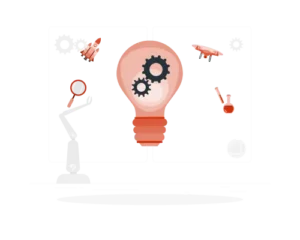Know Your Customer (KYC) Process is an essential process in banking and financial institutions. However, with manual KYC processes, banks and financial institutions face high cost and time challenges, delayed service, inability to comply with KYC rules, and more. But the good news is here for all banking and financial heads! These challenges are easy to overcome with KYC automation.
Yes, automated KYC process! If you are unfamiliar with this term, you have landed on the right page because we will help you become familiar with what KYC is and how it can leverage your KYC process. And also, we will help to take the burden off your shoulders of bad customer experience and delayed services. Even if you are familiar, this article is also for you because you will learn more about it.
This article is a quick guide to RPA in KYC and its benefits to improve your client’s experience with your organization and rapid service delivery.
So, let’s get started!
What is KYC Process?
Before knowing about automated KYC, let us look at the meaning of the KYC process and why it is crucial.
Know Your Customer or Know Your Clients (KYC) identifies and verifies the customers before opening a new account in their name. This process helps to know that the person truly is who he claims to be. KYC helps banks or financial institutions from possible criminal activities such as money laundering, terrorism funding, etc.
The other two aspects of KYC include Anti-Money Laundering (AML) and Customer Due Diligence (CDD). Since the purpose of KYC is to eliminate the possibilities of fraudulence and money laundering, banks must comply with KYC requirements. However, the manual process makes it a challenge. Banks and financial institutions face a clash between growing demands to comply with stringent KYC regulations and a lag in KYC processing.
But with RPA in banking and RPA in KYC, you can slay these giants. Let us learn how.
What is KYC Automation?
KYC automation uses advanced technologies such as Robotic Process Automation (RPA), Artificial Intelligence (AI), and Machine Learning (ML) to take over activities that are dull, repetitive, and rule-based.Using these advanced technologies helps customers experience quick service delivery, and it also eliminates any dependency on internal resources.
In the KYC process, activities that require a lot of legwork is taken care of by RPA with minimal human intervention.
Let us now see what the benefits of RPA in KYC are.
Top 10 Benefits of KYC Automation
Now that we know the meaning of automated KYC, let us see how Robotic Process Automation (RPA) in KYC helps improve customer experience and deliver quick services.
Reduction in Error Rate
Humans make mistakes. But these mistakes in the financial and banking sector proves to be costly.
Therefore, the first benefit of RPA in KYC is a reduction in error rate. Once the KYC process is automated, human intervention is minimized to end-to-end processes where a high level of decision making is required. It brings error rates to 0% and increases the efficiency of the KYC process.
Reduction in Backlog
With so many requests coming each day to create a new account, the banks are left to validate piles of documents each day. Using the traditional method to manually validate documents makes backlog, resulting in poor customer experience or many customers opting out.
However, with robotic process automation in banking, these backlogs can be reduced to 0%. As these backlogs reduce, the customer onboarding service becomes quicker.
Transparency in Data
The traditional KYC process disables the financial head to have a complete overview of data and reports.
But with the implementation of RPA in KYC, financial heads get access to reports and data in a user-friendly format. All the data is well-organized in automated KYC giving enhanced visibility and control to the financial leaders.
Reduced Turn-Around Time (TAT)
Humans can get tired of the dullness of toggling between files and folders, but robots don’t. RPA bots work 24/7 without any tea break or leave, slashing 80% of the time taken in manual onboarding. As the turn-around time is reduced, banks can increase client onboarding yearly.
Improved Compliance Management
As per the reports, banking and financial institutions have paid over $321 billion in penalties and fines for non-compliance with KYC regulations since 2008.
Therefore, to save your banking organization from paying such a large amount of fines and penalties due to non-compliance, integrating RPA in banking is the solution.
Thus, automating the KYC process not only saves you from paying a large sum of fines but also saves costs.
Greater Security
KYC process is essential to keep any criminal activities and terrorism funding at bay. This reason itself makes it necessary to verify all the documents with an eagle’s eye.
Regardless of analysts keeping a close eye on every detail, they can still miss some details, but not with RPA bots. They can check a person’s information across the web for any positive/negative news, all public systems and databases, internal systems, a commercial database, etc.
After verifying from more than one or two sources, the bots create a new account or reject the same.
Reduction in Cost
Excellent Scalability
A manual process is not only slow and prone to error but also unscalable. Since it causes delay, it also slacks in adapting to new requirements and changes.
Contrarily, RPA bots work 24/7 and quickly adapt to frequent variations in KYC rules, internal development, or possible foreign threats. This quick adaptation function brings excellence in scalability in the KYC process.
Best Use of Resources
But not anymore! Make the best use of your human resources by automating repetitive and rule-based KYC processes and engaging them in more creative and value-driven tasks.
Improved Customer Relation
Every business works to bring complete satisfaction to their customers and cater to their needs. Yet, many financial institutions struggle to satisfy their customer because of delayed services.
So, to improve relations with your customers, automate your KYC process. It will give your customers a frictionless experience without waiting for customer executives to answer their queries.
Automated KYC accelerate the process by registering the same queries and replying instantly, improving customer experience and relation.
Conclusion
Did you see how easy RPA in banking and RPA in KYC makes the functioning of the process? Yes, these are the benefits that you can reap for your KYC process by automating it. And these benefits start harvesting in the form of improved customer experience, quick service delivery, high revenues, etc.
If you benefitted from this article, share it with your people and let them also see the benefits of KYC automation.
But Why Only See? Why Not Experience?
Yes, why only just read about the benefits of automated KYC? Go ahead and automate your KYC process now!
But how?
Well, with RPATech!
Click on the link now and book a free demo! Or, to connect with our experts, call us at +91-8010-369-369. You can also write your queries to us at hello@rpatech.ai.




